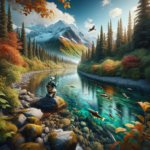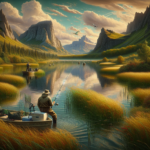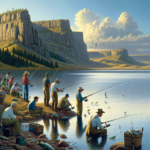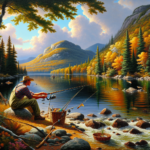Fishing in California: From Coastal Waters to Mountain Lakes
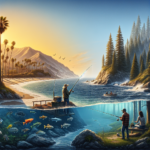
Introduction
Did you know that California boasts over 3,000 miles of coastline and more than 4,000 lakes and reservoirs? This makes it one of the most diverse and exciting places for fishing enthusiasts. Whether you’re casting a line in the Pacific Ocean or fly fishing in a serene mountain lake, California offers a plethora of opportunities for anglers of all skill levels.
In this article, we will explore the rich fishing landscape of California, covering everything from coastal waters to mountain lakes. We will delve into the various fishing techniques, species you can target, top fishing spots, and essential gear. Additionally, we will discuss seasonal considerations, local events, and tournaments, as well as provide tips and best practices to enhance your fishing experience.
Understanding the diverse fishing opportunities in California is crucial for anyone looking to make the most of their angling adventures. Whether you’re a seasoned pro or a beginner, this guide will help you find the best spots, master effective techniques, and ensure a successful and enjoyable fishing trip.
Background/Context
Historical or Cultural Significance
Fishing has been an integral part of California’s history and culture for centuries. Indigenous tribes relied on the state’s abundant waterways for sustenance long before European settlers arrived. Over time, fishing evolved from a means of survival to a popular recreational activity, contributing significantly to the state’s economy and tourism industry.
Geographical Overview
California’s diverse geography includes a vast coastline along the Pacific Ocean, numerous rivers, and an array of lakes and reservoirs nestled in its mountainous regions. The state’s climate varies from Mediterranean along the coast to alpine in the mountains, creating unique ecosystems that support a wide variety of fish species.
Key Points/Details
Fishing Techniques
Technique Overview
California offers a range of fishing techniques suitable for different environments and species. Some of the most popular techniques include:
- Surf Fishing: Ideal for coastal areas, this technique involves casting from the shore into the surf zone.
- Fly Fishing: Commonly used in rivers and mountain lakes, fly fishing requires specialized gear and techniques to mimic the movement of insects on the water’s surface.
- Deep-Sea Fishing: This technique involves fishing in the open ocean, often targeting larger species like tuna and marlin.
- Lake Fishing: Suitable for both boat and shore fishing, this technique can target a variety of freshwater species.
When and Where to Use
Each technique has its ideal conditions and locations:
- Surf Fishing: Best along sandy beaches and rocky shores, particularly during high tide.
- Fly Fishing: Ideal in rivers and streams during insect hatches, typically in spring and early summer.
- Deep-Sea Fishing: Most productive during the summer months when pelagic species migrate closer to shore.
- Lake Fishing: Effective year-round, with peak seasons varying by species and location.
Recommended Gear
Essential gear for each technique includes:
- Surf Fishing: Long rods (9-12 feet), spinning reels, heavy lines (20-30 lb test), and bait like sand crabs or shrimp.
- Fly Fishing: Fly rods (8-9 feet), fly reels, floating lines, and a selection of dry flies, nymphs, and streamers.
- Deep-Sea Fishing: Heavy-duty rods and reels, braided lines (50-100 lb test), and lures or live bait like mackerel.
- Lake Fishing: Medium rods (6-7 feet), spinning or baitcasting reels, monofilament lines (6-12 lb test), and a variety of lures or live bait.
Species Information
Species Overview
California’s waters are home to a diverse array of fish species, including:
- Coastal Waters: Halibut, striped bass, surfperch, and various rockfish species.
- Rivers and Streams: Rainbow trout, steelhead, and salmon.
- Mountain Lakes: Brown trout, brook trout, and kokanee salmon.
- Deep-Sea: Tuna, marlin, and yellowtail.
Best Practices
To successfully catch these species, consider the following tips:
- Halibut: Use live bait like anchovies or sardines, and fish near sandy bottoms during incoming tides.
- Rainbow Trout: Fly fishing with dry flies or nymphs is effective, especially during insect hatches.
- Tuna: Trolling with lures or live bait in offshore waters during summer months yields the best results.
Location Information
Top Fishing Spots
Some of the best fishing spots in California include:
- Monterey Bay: Known for its rich marine life, offering opportunities for surf fishing, deep-sea fishing, and more.
- Lake Tahoe: A prime location for trout fishing, with stunning alpine scenery.
- San Francisco Bay: Offers diverse fishing opportunities, including striped bass and halibut.
- Eastern Sierra Lakes: Renowned for their trout fishing, particularly in Mammoth Lakes and June Lake Loop.
Regulations and Licenses
California requires a fishing license for anyone 16 years or older. Specific regulations, including catch limits and seasonal restrictions, vary by location and species. It’s essential to check the California Department of Fish and Wildlife (CDFW) website for up-to-date information before heading out.
Seasonal Considerations
Seasonal Variations
Fishing conditions in California change throughout the year:
- Spring: Ideal for trout fishing in rivers and streams, as well as surf fishing along the coast.
- Summer: Peak season for deep-sea fishing and lake fishing, with warm waters attracting a variety of species.
- Fall: Excellent for salmon runs in rivers and steelhead fishing.
- Winter: Slower season but still productive for certain species like surfperch and winter steelhead.
Best Times to Fish
The optimal times for fishing vary by species and location. Generally, early morning and late afternoon are the best times to fish, as many species are more active during these periods. Additionally, tidal movements and moon phases can significantly impact fishing success, particularly in coastal areas.
Events and Tournaments
Event Overview
California hosts numerous fishing events and tournaments throughout the year, including:
- California Open at Clear Lake: A popular bass fishing tournament held annually in April.
- King of the Harbor: A kayak fishing tournament in Santa Barbara, targeting various coastal species.
- Trout Fest: Family-friendly events held at various locations, offering educational activities and fishing opportunities.
Preparation Tips
To prepare for these events, consider the following tips:
- Gear: Ensure your gear is in top condition and suited for the target species.
- Practice: Spend time practicing your casting and retrieval techniques to improve accuracy and efficiency.
- Strategy: Research the event location and develop a strategy based on local conditions and fish behavior.
Tips and Best Practices
General Tips
Here are some practical tips to enhance your fishing experience:
- Stay Informed: Keep up-to-date with local fishing reports and conditions.
- Be Patient: Fishing requires patience and persistence; don’t get discouraged by slow days.
- Respect Nature: Follow ethical fishing practices and respect local wildlife and habitats.
Avoid Common Mistakes
Common mistakes to avoid include:
- Overcasting: Casting too far can scare fish away; aim for accuracy over distance.
- Ignoring Regulations: Always adhere to local fishing regulations to avoid fines and protect fish populations.
- Using the Wrong Gear: Ensure your gear matches the target species and fishing conditions.
Advanced Techniques
For more experienced anglers, consider these advanced techniques:
- Match the Hatch: In fly fishing, use flies that closely resemble local insect hatches to increase your chances of success.
- Drift Fishing: In rivers, allow your bait or lure to drift naturally with the current to mimic prey movement.
- Chumming: In deep-sea fishing, use chum to attract fish to your location.
Gear and Equipment Recommendations
Essential Gear
The essential gear for fishing in California includes:
- Rods and Reels: Choose rods and reels suited to your target species and fishing technique.
- Lines: Use appropriate lines for the fishing conditions, whether monofilament, braided, or fluorocarbon.
- Bait and Lures: Stock up on a variety of bait and lures to match local fish preferences.
- Tackle Box: Keep your gear organized with a well-stocked tackle box.
Optional Gear/Upgrades
Consider these additional items to enhance your fishing experience:
- Fish Finder: A fish finder can help locate fish in deeper waters.
- Waders: Useful for fly fishing in rivers and streams.
- Kayak or Boat: Provides access to more remote fishing spots.
Where to Buy or Rent
You can purchase or rent fishing gear from local shops or online retailers. Some popular options include:
- Local Tackle Shops: Many coastal and inland towns have specialized fishing stores with knowledgeable staff.
- Online Retailers: Websites like Bass Pro Shops, Cabela’s, and Amazon offer a wide range of fishing gear.
- Rental Services: Some locations offer gear rental services, particularly for deep-sea fishing trips.
Safety and Conservation
Safety Tips
Ensure a safe fishing trip by following these tips:
- Check Weather Conditions: Always check the weather forecast before heading out, especially for coastal or deep-sea fishing.
- Wear Life Jackets: When fishing from a boat or kayak, always wear a life jacket.
- Stay Hydrated: Bring plenty of water, especially during hot weather.
Conservation Practices
Promote sustainable fishing by adhering to these practices:
- Catch and Release: Practice catch and release for non-target species or when regulations require it.
- Respect Limits: Follow local catch limits to help maintain fish populations.
- Avoid Littering: Dispose of trash and fishing line properly to protect the environment.
Planning Your Trip
Accommodations
Consider these accommodation options near popular fishing spots:
- Monterey Bay: Numerous hotels and vacation rentals are available in Monterey and Santa Cruz.
- Lake Tahoe: Choose from lakeside cabins, hotels, and campgrounds.
- Eastern Sierra Lakes: Options include lodges, motels, and campgrounds in Mammoth Lakes and June Lake.
Travel Tips
Plan your travel with these tips:
- Routes: Use major highways like Highway 1 for coastal areas and Highway 395 for the Eastern Sierra.
- Transportation: Renting a car is often the best option for accessing remote fishing spots.
- Permits: Ensure you have any necessary permits for accessing certain areas or launching boats.
Additional Activities
Enhance your trip with these additional activities:
- Hiking: Explore scenic trails near fishing spots, such as those in Yosemite National Park or Big Sur.
- Wildlife Viewing: Many fishing locations offer opportunities to see diverse wildlife, including birds, marine mammals, and more.
- Local Attractions: Visit nearby attractions like the Monterey Bay Aquarium or Lake Tahoe’s ski resorts.
Frequently Asked Questions (FAQs)
Do I need a fishing license in California?
Yes, anyone 16 years or older needs a fishing license to fish in California. Licenses can be purchased online or at local retailers.
What are the best times of year to fish in California?
The best times vary by species and location, but generally, spring and summer are ideal for most types of fishing. Fall is excellent for salmon and steelhead, while winter offers opportunities for surfperch and winter steelhead.
Can I fish in California’s national parks?
Yes, fishing is allowed in many of California’s national parks, but specific regulations and restrictions apply. Always check with park authorities before fishing.
What should I do if I catch a fish I don’t intend to keep?
Practice catch and release by handling the fish gently, using barbless hooks, and releasing it quickly back into the water to minimize stress and injury.
Conclusion
Fishing in California offers a diverse and rewarding experience, from the coastal waters of the Pacific Ocean to the serene mountain lakes. By understanding the various techniques, species, and locations, you can make the most of your fishing adventures. Remember to follow local regulations, practice conservation, and prioritize safety to ensure a successful and enjoyable trip. Whether you’re a seasoned angler or a beginner, California’s rich fishing landscape has something to offer everyone. So grab your gear, plan your trip, and get ready to explore the incredible fishing opportunities that await you in the Golden State.
Happy fishing!

